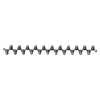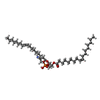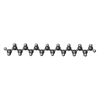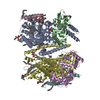+Search query
-Structure paper
| Title | The structure of the TMC-2 complex suggests roles of lipid-mediated subunit contacts in mechanosensory transduction. |
|---|---|
| Journal, issue, pages | Proc Natl Acad Sci U S A, Vol. 121, Issue 8, Page e2314096121, Year 2024 |
| Publish date | Feb 20, 2024 |
 Authors Authors | Sarah Clark / Hanbin Jeong / Rich Posert / April Goehring / Eric Gouaux /  |
| PubMed Abstract | Mechanotransduction is the process by which a mechanical force, such as touch, is converted into an electrical signal. Transmembrane channel-like (TMC) proteins are an evolutionarily conserved family ...Mechanotransduction is the process by which a mechanical force, such as touch, is converted into an electrical signal. Transmembrane channel-like (TMC) proteins are an evolutionarily conserved family of membrane proteins whose function has been linked to a variety of mechanosensory processes, including hearing and balance sensation in vertebrates and locomotion in . TMC1 and TMC2 are components of ion channel complexes, but the molecular features that tune these complexes to diverse mechanical stimuli are unknown. express two TMC homologs, TMC-1 and TMC-2, both of which are the likely pore-forming subunits of mechanosensitive ion channels but differ in their expression pattern and functional role in the worm. Here, we present the single-particle cryo-electron microscopy structure of the native TMC-2 complex isolated from . The complex is composed of two copies of the pore-forming TMC-2 subunit, the calcium and integrin binding protein CALM-1 and the transmembrane inner ear protein TMIE. Comparison of the TMC-2 complex to the recently published cryo-EM structure of the TMC-1 complex highlights conserved protein-lipid interactions, as well as a π-helical structural motif in the pore-forming helices, that together suggest a mechanism for TMC-mediated mechanosensory transduction. |
 External links External links |  Proc Natl Acad Sci U S A / Proc Natl Acad Sci U S A /  PubMed:38354260 / PubMed:38354260 /  PubMed Central PubMed Central |
| Methods | EM (single particle) |
| Resolution | 2.9 Å |
| Structure data | EMDB-41356, PDB-8tkp: |
| Chemicals |  ChemComp-TWT:  ChemComp-PEE:  ChemComp-R16:  ChemComp-CLR:  ChemComp-NAG:  ChemComp-CA:  ChemComp-PLM: |
| Source |
|
 Keywords Keywords | MEMBRANE PROTEIN / Mechanosensory transduction Macromolecular complex |
 Movie
Movie Controller
Controller Structure viewers
Structure viewers About Yorodumi Papers
About Yorodumi Papers






